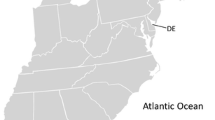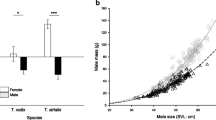Abstract
Sperm number is often a good predictor of success in sperm competition; however, it has become increasingly clear that, for some species, variation in probability of paternity cannot be explained by sperm number alone. Intraspecific variation in ejaculate characteristics, such as the number of viable sperm and sperm longevity, may play an equally important role in determining fertilization success. Here, we assess variation among ejaculates in three factors that may contribute to fertilization success (number of sperm per ejaculate, viability, and longevity), in a population of Peron’s tree frog (Litoria peronii). We detected large variation among males in the number of sperm per ejaculate and the proportion of viable sperm within ejaculates, which could not be explained by variation in either male size or body condition. However, the proportion of viable sperm released by males increased over the season. Finally, we assessed sperm longevity (proportion viable sperm determined using a dual-fluorochrome vital dye) at two different temperatures. At 23°C, on average, 75% of sperm remained viable after 2 h, but there were significant differences amongst males with the percentage of viable sperm ranging from 43% to 95%. For sperm incubated at 4°C, ejaculates varied fivefold in sperm longevity with some males having 50% viable sperm after 5 days. Our data suggest that ejaculate characteristics (sperm number, viability, and longevity) vary widely in Peron’s tree frog and may therefore play an important role in determining siring success both in the presence and absence of sperm competition. We discuss the results in relation to selection on ejaculate traits via natural and sexual selection in this and other amphibians.

Similar content being viewed by others
References
Anstis M (2002) Tadpoles of south–eastern Australia. Reed New Holland, Sydney
Ashizawa K, Wishart GJ (1992) Factors from fluid of the ovarian pocket that stimulate sperm motility in domestic hens. J Reprod Fertil 95:855–860
Ball MA, Parker GA (1997) Sperm competition games: inter- and intra-species results of a continuous external fertilization model. J Theor Biol 186:459–466
Beesley SG, Costanzo JP, Lee RE (1998) Cryopreservation of spermatozoa from freeze-tolerant and -intolerant anurans. Cryobiology 37:55–162
Berger L, Rybacki M, Hotz H (1994) Artificial fertilization of water frogs. Amphibia-Reptilia 15:408–413
Birkhead TR, Møller AP (1998) Sperm competition and sexual selection. Academic, London
Browne RK, Clulow J, Mahony M (2001) Short-term storage of cane toad (Bufo marinus) gametes. Reproduction 121:167–173
Browne RK, Davis J, Pomering M, Clulow J (2002) Storage of cane toad (Bufo marinus) sperm for 6 days at 0 degrees C with subsequent cryopreservation. Reprod Fert Develop 14:267–273
Burness G, Casselman SJ, Schulte-Hostedde AI, Moyes CD, Montgomerie R (2004) Sperm swimming speed and energetics vary with sperm competition risk in bluegill (Lepomis macrochirus). Behav Ecol Sociobiol 56:65–70
Byrne PG, Roberts JD, Simmons LW (2002) Sperm competition selects for increased testes mass in Australian frogs. J Evolution Biol 15:347–355
Edwards DL, Mahony MJ, Clulow J (2004) Effect of sperm concentration, medium osmolality and oocyte storage on artificial fertilisation success in a myobatrachid frog (Limnodynastes tasmaniensis). Reprod Fert Develop 16:347–354
Elofsson H, McAllister BG, Kime DE, Mayer I, Borg B (2003) Long lasting stickleback sperm; is ovarian fluid a key to success in fresh water? J Fish Biol 63:240–253
Gage MJG, Stockley P, Parker GA (1995) Effects of alternative male mating strategies on characteristics of sperm production in the Atlantic salmon (Salmo salar): theoretical and empirical investigations. Philos Trans R Soc Lond B Biol Sci 350:391–399
Garner DL, Johnson LA (1995) Viability assessment of mammalian sperm using SYBR-14 and propidium iodide. Biol Reprod 53:276–284
Gomendio M, Roldan ERS (1991) Sperm competition influences sperm size in mammals. Proc Biol Sci 243:181–185
Gomendio M, Harcourt AH, Roldan ERS (1998) Sperm competition in mammals. In: Birkhead TR, Møller AP (eds) Sperm competition and sexual selection. Academic, London, pp 667–755
Gomendio M, Martin-Coello J, Crespo C, Magana C, Roldan ERS (2006) Sperm competition enhances functional capacity of mammalian spermatozoa. Proc Natl Acad Sci U S A 103:15113–15117
Griffiths K (2006) Frogs and reptiles of the Sydney region. New Holland, Sydney
Guex GD, Hotz H, Semlitsch RD (2002) Deleterious alleles and differential viability in progeny of natural hemiclonal frogs. Evolution 56:1036–1044
Harcourt AH, Harvey PH, Larson SG, Short RV (1981) Testis weight, body weight and breeding system in primates. Nature 293:55–57
Hettyey A, Roberts JD (2006) Sperm traits of the quacking frog, Crinia georgiana: intra- and interpopulation variation in a species with a high risk of sperm competition. Behav Ecol Sociobiol 59:389–396
Hettyey A, Roberts JD (2007) Sperm traits in the quacking frog (Crinia georgiana), a species with plastic alternative mating tactics. Behav Ecol Sociobiol 61:1303–1310
Hunter FM, Birkhead TR (2002) Sperm viability and sperm competition in insects. Curr Biol 12:121–123
Jakob EM, Marshall SD, Uetz GW (1996) Estimating fitness: a comparison of body condition indices. Oikos 77:61–67
Kotiaho JS (1999) Estimating fitness: comparison of body condition indices revisited. Oikos 87:399–400
Laurila A, Karttunnen S, Merilä J (2002) Adaptive phenotypic plasticity and genetics of larval life histories in two Rana temporaria populations. Evolution 56:617–627
Littell RC, Millikrn GA, Stroup WW, Wolfinger RD (1996) SAS system for mixed models. SAS Institute Inc, Cary
Mann T, Lutwak-Mann C (1981) Males reproductive function and semen. Springer, Berlin
Matthews IM, Evans JP, Magurran AE (1997) Male display rate reveals ejaculate characteristics in the Trinidadian guppy Poecilia reticulata. Proc Biol Sci 264:695–700
Moore FL (1983) Behavioral endocrinology of amphibian reproduction. BioScience 33:557–561
Moore FL, Miller LJ, Spielvogel SP, Kubiak T, Folkers K (1982) Luteinizing hormone-releasing hormone involvement in the reproductive behavior of a male amphibian. Neuroendocrinology 35:212–216
Møller AP (1988) Testes size, ejaculate quality and sperm competition in birds. Biol J Linn Soc 33:273–283
Møller AP (1989) Ejaculate quality, testes size and sperm production in mammals. Funct Ecol 3:91–96
Møller AP, Briskie JV (1995) Extra-pair paternity, sperm competition and the evolution of testis size in birds. Behav Ecol Sociobiol 36:357–365
Neff BD, Fu P, Gross MR (2003) Sperm investment and alternative mating tactics in bluegill sunfish (Lepomis macrochirus). Behav Ecol 14:634–641
Olsson M, Shine R (1997) The limits to reproductive output: offspring size versus number in the sand lizard (Lacerta agilis). Am Nat 149:179–188
Parker GA (1998) Sperm competition and the evolution of ejaculates: towards a theory base. In: Birkhead TR, Møller AP (eds) Sperm competition and sexual selection. Academic, London, pp 3–54
Parker GA, Partridge L (1998) Sexual conflict and speciation. Philos Trans R Soc Lond B Biol Sci 353:261–274
Parker GA, Ball MA (2005) Sperm competition, mating rate and the evolution of testis and ejaculate sizes: a population model. Biol Lett 1:235–238
Pitcher TE, Rodd FH, Rowe L (2007) Sexual colouration and sperm traits in guppies. J Fish Biol 70:165–177
Pizzari T, Dean R, Pacey A, Moore H, Bonsall MB (2008) The evolutionary ecology of pre- and post-meiotic sperm senescence. Trend Ecol Evol 23:131–140
Quinn G, Keough M (2002) Experimental design and data analysis for biologists. Cambridge University Press, Cambridge
Reyer HU, Niederer B, Hettyey A (2003) Variation in fertilisation abilities between hemiclonal hybrid and sexual parental males of sympatric water frogs (Rana lessonae, R. esculenta, R. ridibunda). Behav Ecol Sociobiol 54:274–284
Sagvik J, Uller T, Olsson M (2005) Outbreeding depression in the common frog, Rana temporaria. Conserv Genet 6:205–211
Sargent MG, Mohun TJ (2005) Cryopreservation of sperm of Xenopus laevis and Xenopus tropicalis. Genesis 41:41–46
Schärer L, Robertson DR (1999) Sperm and milt characteristics and male v. female gametic investment in the Caribbean reef fish, Thalassoma bifasciatum. J Fish Biol 55:329–343
Schäfer-Somi S, Aurich C (2007) Use of a new computer-assisted sperm analyzer for the assessment of motility and viability of dog spermatozoa and evaluation of four different semen extenders for predilution. Anim Reprod Sci 102:1–13
Sherman CDH, Wapstra E, Uller T, Olsson M (2008a) Males with high genetic similarity to females sire more offspring in sperm competition in Peron's tree frog Litoria peronii. Proc Biol Sci 275:971–978
Sherman CDH, Wapstra E, Uller T, Olsson M (2008b) Male and female effects on fertilisation success and offspring viability in the Peron’s tree frog, Litoria peronii. Austral Ecology 33:348–352
Simmons LW, Kotiaho JS (2002) Evolution of ejaculates: patterns of phenotypic and genotypic variation and condition dependence in sperm competition traits. Evolution 56:1622–1631
Simmons LW, Wernham J, Garcia-Gonzalez F, Kamien D (2003) Variation in paternity in the field cricket Teleogryllus oceanicus: no detectable influence of sperm numbers or sperm length. Behav Ecol 14:539–545
Simmons LW, Denholm A, Jackson C, Levy E, Madon E (2007) Male crickets adjust ejaculate quality with both risk and intensity of sperm competition. Biol Lett 3:520–522
Snook RR (2005) Sperm in competition: not playing by the numbers. Trends Ecol Evol 20:46–53
Turner E, Montgomerie R (2002) Ovarian fluid enhances sperm movement in Arctic charr. J Fish Biol 60:1570–1579
Urbach D, Folstad I, Rudolfsen G (2005) Effects of ovarian fluid on sperm velocity in Arctic charr (Salvelinus alpinus). Behav Ecol Sociobiol 57:438–444
Vetter CM, Miller JE, Crawford LM, Armstrong MJ, Clair JH, Conner MW, Wise LD, Skopek TR (1998) Comparison of motility and membrane integrity to assess rat sperm viability. Reprod Toxicol 12:105–114
Waggener WL, Carroll EJ (1998) A method for hormonal induction of sperm release in anurans (eight species) and in vitro fertilization in Lepidobatrachus species. Dev Growth Differ 40:19–25
Wilson BA, Van der Horst G, Channing A (1998) Comparison of motility patterns of sperm aspirated from amplectant pairs of Xenopus laevis, by electro-ejaculation and from the testes. Herp J 8:51–56
Acknowledgements
This work was supported by Australian Research Council Discovery Grants to MO and EW (Grant # DP0559867) and TU (grant # DP0664403). We thank Ken Griffiths, Carlos Reyes, Glen Murray, and Adam Moore for their help with field and laboratory work, the Fahey family for access to breeding ponds at Darkes forest, and three anonymous reviewers for their insightful comments. TU was supported by the Wenner-Gren Foundations. All works were carried out in accordance with National Parks and Wildlife Services permit S11186, the University of Wollongong Animal Ethics Committee (permits AE04/03–05), and comply with the current laws of Australia.
Author information
Authors and Affiliations
Corresponding author
Rights and permissions
About this article
Cite this article
Sherman, C.D.H., Uller, T., Wapstra, E. et al. Within-population variation in ejaculate characteristics in a prolonged breeder, Peron’s tree frog, Litoria peronii . Naturwissenschaften 95, 1055–1061 (2008). https://doi.org/10.1007/s00114-008-0423-7
Received:
Revised:
Accepted:
Published:
Issue Date:
DOI: https://doi.org/10.1007/s00114-008-0423-7




